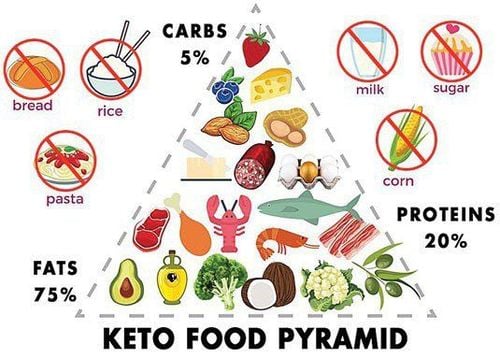This is an automatically translated article.
Posted by Master, Doctor Mai Vien Phuong - Department of Examination & Internal Medicine - Vinmec Central Park International General Hospital
Keto diet is an acronym for ketogenic, which is a diet low in carbohydrates and high in good fats. With the Keto diet will help our body burn more energy without having to go on a strict diet.
1. Sample keto menu for a day
This sample keto menu is a good example of a day of the Keto diet. You can rely on the basic principles of this diet to design your daily menu:
Breakfast: 2 fried eggs with olive or avocado oil, 1 slice of salmon; Mid-morning snack: Almonds or cashews; Lunch: Chicken breast, bell pepper, mixed vegetable with oil; Mid-afternoon snack: Cheese; Dinner: Beef, vegetables, mushrooms; As with any keto diet, perseverance is also an important factor for beginners to get the best results possible. In addition, you should also not forget to combine exercise and reasonable rest with nutrition to maintain a healthy body.
2. Different Types of Ketogenic Diets
There are several versions of the ketogenic diet, including:
Standard ketogenic diet (SKD): This is a very low carb, moderate protein and high fat diet. It usually contains 70% fat, 20% protein and only 10% carbs. Cyclic ketogenic diet (CKD): This diet includes periods of higher carb intake, such as 5 ketogenic days followed by 2 high carb days. Targeted Ketogenic Diet (TKD): This diet allows you to add carbs around your workouts. High-protein ketogenic diet: This is similar to the standard ketogenic diet, but includes more protein. The ratio is usually 60% fat, 35% protein, and 5% carbs. However, only the standard and high-protein ketogenic diet has been extensively studied. Cyclic or targeted ketogenic diets are more advanced methods and are mainly used by bodybuilders or athletes.

3. The role of the ketogenic diet in metabolic diseases
Here are the benefits of the ketogenic diet for metabolic diseases.
3.1 Metabolic syndrome Metabolic syndrome, sometimes called prediabetes, is characterized by insulin resistance. You can be diagnosed with metabolic syndrome if you meet any of the following 3 criteria:
Large waist circumference: 35 inches (89 cm) or more in women and 40 inches (102 cm) or more in men gender. Increased triglycerides: 150 mg/dl (1.7 mmol/L) or higher. Low HDL cholesterol: Less than 40 mg/dL (1.04 mmol/L) in men and less than 50 mg/dL (1.3 mmol/L) in women. High blood pressure: 130/85 mm Hg or higher. Fasting hyperglycemia: 100 mg/dL (5.6 mmol/L) or higher. People with metabolic syndrome are at increased risk for diabetes, heart disease, and other serious disorders associated with insulin resistance.
Following a ketogenic diet can improve many features of metabolic syndrome. Improvements may include better cholesterol values, as well as reduced blood sugar and blood pressure. In a controlled 12-week study, people with metabolic syndrome who followed a calorie-restricted ketogenic diet lost 14% of their body fat. They reduced triglycerides by more than 50% and experienced several other improvements in markers of health.
The ketogenic diet can reduce belly fat, triglycerides, blood pressure, and blood sugar in people with metabolic syndrome.
3.2 Glycogen Storage Disease People with glycogen storage disease (GSD) lack one of the enzymes involved in storing glucose (blood sugar) as glycogen or breaking down glycogen into glucose. There are several types of GSD, each based on the type of enzyme that is missing. Most often, this disease is diagnosed in childhood. Symptoms vary depending on the type of GSD, and can include poor growth, fatigue, low blood sugar, muscle cramps, and an enlarged liver.
GSD patients are often advised to consume carbohydrate-rich foods regularly so that glucose is always available in the body. However, early research suggests that the ketogenic diet may be beneficial for people with some forms of GSD. For example, GSD III, also known as Forbes-Cori disease, affects the liver and muscles. The ketogenic diet can help relieve symptoms by providing ketones that can be used as an alternative fuel source. GSD V - also known as McArdle disease, affects the muscles and is characterized by limited exercise capacity.
In one case, a man with GSD V followed a ketogenic diet for a year. Depending on the level of exertion required, he experienced a dramatic 3 to 10x increase in exercise tolerance. However, controlled studies are needed to confirm the potential benefits of ketogenic diet therapy in individuals with glycogen storage disease.
People with certain types of glycogen storage diseases can see significant improvement in their symptoms while following the ketogenic diet. However, more research is needed.

3.3 Diabetes People with diabetes often experience dramatic reductions in blood sugar when following the ketogenic diet. This is true for both type 1 and type 2 diabetes. Dozens of controlled studies show that very low-carbohydrate diets help control blood sugar and may also provide other health benefits.
In a 16-week study, 17 out of 21 people on a ketogenic diet were able to stop or reduce the dose of their diabetes medication. Study participants also lost an average of 19 pounds (8.7kg) and reduced waist size, triglycerides, and blood pressure.
In a 3-month study comparing a ketogenic diet with a moderate carbohydrate diet, people in the ketogenic group lost an average of 0.6% HbA1c. 12% of participants achieved an HbA1c below 5.7%, which is considered normal.
The ketogenic diet has been shown to lower blood sugar in people with diabetes. In some cases, values return to normal and the drug can be discontinued or reduced.
3.4 Obesity Many studies show that a ketogenic, very low-carbohydrate diet is often more effective for weight loss than a calorie-restricted or low-fat diet. Furthermore, they often provide other health improvements as well.
In a 24-week study, men following a ketogenic diet lost twice as much fat as men on a low-fat diet.
In addition, the triglycerides of the ketogenic group decreased significantly, and their HDL (“good”) cholesterol increased. The low-fat group had lower triglycerides and lower HDL cholesterol. The ability of the ketogenic diet to reduce hunger is one of the reasons why they are so effective for weight loss.
One large analysis found that a very low-carbohydrate, calorie-restricted ketogenic diet helped people feel less hungry than a standard calorie-restricted diet. Even when people following a ketogenic diet are allowed to eat all they want, they often eat fewer calories due to the appetite-suppressing effect of ketosis.
In a study of obese men who consumed a ketogenic diet that did not restrict calories or moderate carbohydrates, those in the ketogenic group were significantly less hungry, took in fewer calories, and lost more weight 31 % compared to the moderate carbohydrate group.
Studies have found that the ketogenic diet is very effective for weight loss in obese people. This is largely due to their powerful appetite-suppressing effects.

3.5 GLUT1 Deficiency Syndrome Glucose transporter 1 deficiency syndrome (GLUT1), a rare genetic disorder, involves a deficiency of a particular protein that helps move blood sugar into the brain. Symptoms usually begin soon after birth and include growth retardation, mobility difficulties, and sometimes seizures.
Unlike glucose, ketones do not require this protein to travel from the blood to the brain. Thus, the ketogenic diet could provide an alternative fuel source that these children's brains can effectively use. Ketogenic diet therapy seems to improve some symptoms of the disorder. Researchers report a decrease in seizure frequency and improved muscle coordination, alertness, and concentration in children on a ketogenic diet.
As with epilepsy, the modified Atkins diet (MAD) has been shown to provide the same benefits as the classic ketogenic diet. However, MAD offers greater flexibility, which can lead to better compliance and fewer side effects. In a study of 10 children with GLUT1 deficiency syndrome, those who followed MAD experienced improved seizures. After six months, 3 out of 6 people do not have a seizure.
Both the classic ketogenic diet and the more flexible MAD diet have been shown to improve seizures and other symptoms in children with GLUT1 deficiency syndrome.
3.6 Non-alcoholic fatty liver disease Nonalcoholic fatty liver disease (NAFLD) is the most common liver disease in the Western world. It is strongly associated with type 2 diabetes, metabolic syndrome, and obesity, and there is evidence that NAFLD also improves on a very low-carbohydrate ketogenic diet.
In one small study, 14 obese men with metabolic syndrome and NAFLD who followed a ketogenic diet for 12 weeks experienced significant reductions in weight, blood pressure, and liver enzymes. Furthermore, 93% of men had an impressive reduction in liver fat and 21% achieved complete resolution of NAFLD.
The ketogenic diet can be very effective in reducing liver fat and other health markers in people with nonalcoholic fatty liver disease.
In summary, the ketogenic diet is being considered for use in a number of disorders due to their beneficial effects on metabolic and nervous system health. However, many of these impressive results come from case studies and need to be confirmed through higher-quality research, including randomized controlled trials.
Please dial HOTLINE for more information or register for an appointment HERE. Download MyVinmec app to make appointments faster and to manage your bookings easily.














